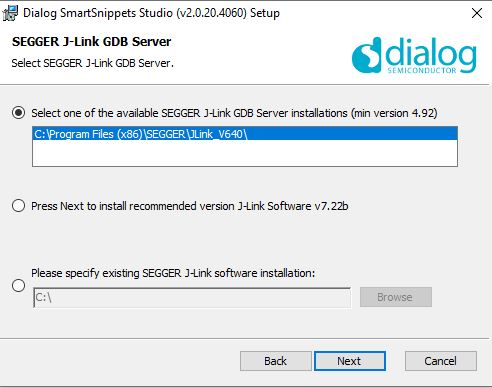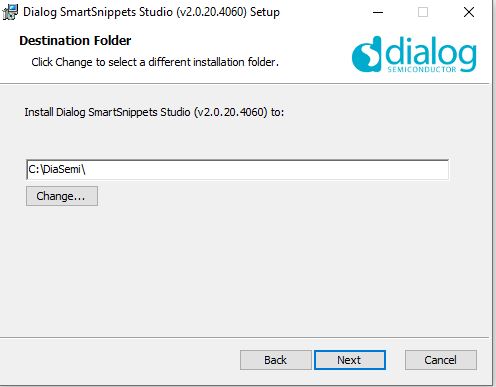8. Appendices
Adjusting the FTDI Cable Latency Timer
When using an external FTDI cable for OTP burning or image downloading to external memory, it is important to set the FTDI cable’s latency timer to less than 10 ms.
Complete the steps below to change the latency timer:
Open the Windows Device Manager.
In the Device Manager, expand the list of COM ports.
Right-click on the COM port relevant to your setup and select Properties.
In the Port Settings tab, click Advanced.
Set the Latency Timer to a value less than 10 ms.
Click OK to save the changes and then close the Device Manager.
Single Wire UART Configuration for Blinky Project
On the FCGQFN24 package, P0_5 is assigned to a single wire UART signal RxTx. To enable this on DA14531 PRO-Development kit, three additional jumpers need to be added.
GPIO |
Function |
Jumper Configuration |
|
|---|---|---|---|
P0_5 |
UART2 TX (Single Wire) |
J1.19 – J1.20 / J10.1 – J1.15 / J10.2 – J1.17 |
|
P0_9 |
LED |
J8.3 – J8.4 |
|
Figure 41 UART2 single wire jumper configuration DA14531
SPI Flash Programming
You can burn data into the SPI flash using SST (SPI Serial Transfer) over a single UART connection. However, there are specific pin configurations you need to follow for this setup. When programming the SPI flash using 2-wire UART, you need to perform OTP (One-Time Programmable) programming. This is because the default SPI pins are shared with the default UART pins (P0_0/P0_1). For detailed information on how to configure the pins and perform this process, see Section 8.3 in the AN-B-072.
Function |
Signal |
|---|---|
MOSI J1:3-4 (Default) |
P0_0 |
FCS J1:7-8 (Default) |
P0_1 |
MISO J1:9-10 (Default) |
P0_3 |
SCK J1:5-6 (Default) |
P0_4 |
Figure 43 Default SPI configuration
Hint
For SPI flash programming steps with SmartSnippets™ Toolbox, see UM-B-083: program SPI/EEprom: SPI Flash Programmer.
For an SPI flash programming Keil® example, see SPI Flash Memory Example.
SPI Flash Programming Using Single Wire UART
Use of the Single Wire UART to Download Code in SPI Flash is also possible. The figure below shows the default configuration on Prodevkit and SmartSnippets™ Toolbox:
Figure 44 SPI flash programing through UART: Pin configuration
Adding Arm Compiler 5 in Keil® MDK
Warning
From SDK6.0.18, the only compatible ARM compiler is version 6. This special instruction is for SDK6.0.16 or lower.
The Arm Compiler 5 is no longer included as part of the installation from Keil® MDK 5.37 and later versions. If you need to build your project using Arm Compiler 5, you can add Arm Compiler 5 into your Keil MDK installation manually as follows:
Download the latest ARM Compiler 5 version from the Legacy ARM compilers download page
Choose to install it into the
ARMsub directory of the Keil® MDK installation directory. If Keil® is installed in the default directory, install the ARM compiler inC:\Keil_v5\ARM\ARM_Compiler_5.XXuXRegister and add the installed Arm Compiler 5 release:
Open the dialog Project - Manage - Project Items - Folders/Extensions:

Figure 45 Manage Arm Compiler version
Click the … button on the right side of Use ARM Compiler to open the ARM Compiler Versions. The dialog shows the relative compiler installation path and the compiler version:

Figure 46 Add Arm compiler version
Click Add another Arm Compiler Version to the list. This opens the Browse For Folder dialog. Navigate to the folder that containing the Arm compiler version and click OK to register the compiler. The path to that folder and the Arm compiler version are shown in Figure 46. With these steps, you have registered an additional Arm compiler.

Figure 47 Browse to the compiler version

Figure 48 Compiler version added
8.1. SmartSnippets™ Studio
Renesas SmartSnippets™ Studio is a royalty-free software development platform for Smartbond™ devices. It fully supports the DA1453x family of devices. For the SmartSnippets™ Package, you need to install only SmartSnippets™ Studio.
SmartSnippets™ Toolbox is a comprehensive software development tool that covers various development requirements:
Firmware Management: - SmartSnippets™ Toolbox enables programming and loading firmware into various memory types, including SRAM, OTP, EEPROM, and Flash.
Power Profiling: - It offers power profiling capabilities, allowing you to assess and optimize power consumption for your applications.
Terminal Scripting: - SmartSnippets™ Toolbox provides features for terminal scripting, simplifying interactions with your device and streamlining debugging.
Documentation: - Extensive SmartSnippets™ Toolbox documentation is available to assist you in making the most of this powerful development tool.
SmartSnippets™ Toolbox is an indispensable resource for your software development needs.
SmartSnippets™ Installation
These are the steps to install:
Download the latest version of SmartSnippets™ Studio from Development Tools.
Note: Registration is required in order to download the SmartSnippets.
Warning
Beaware that if you have antivirus software installed on your machine, it could slow down the SmartSnippets™ installation due to the scan.
Run the SmartSnippets™ Studio installer (
.msi). Most of the required tools are automatically installed andm some needs to be manually downloaded and installed.Select the latest version of SEGGER J-Link GDB Server and click Next.

Figure 49 Automatically install J-Link
Select the destination folder for SmartSnippets™ Studio and click Next.

Figure 50 Select SmartSnippets™ Studio installation directory
The SmartSnippets™ Studio is installed.
Hints
The default Windows installation folder for SmartSnippets™ Studio is
C:\DiaSemiWhen Windows Defender is turned ON, it prevents the SmartSnippets™ Studio installer (
.msi) from running automatically. When prompted, click Run AnywayAdministrator access is required to install SmartSnippets Studio software components.
For more information on the installation procedure of SmartSnippets™ Studio, see the UM-B-057 SmartSnippets Studio User Manual.
